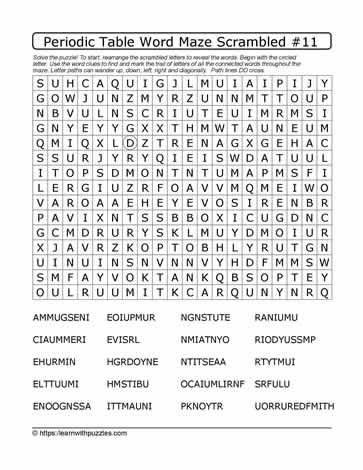Periodic Scrambled Maze#11( |
Here is a periodic table of elements word maze puzzle, with scrambled letter word clues, that activates students' critical thinking and problem solving skills. Together, the list of 20 periodic elements' letter paths create an intricate maze-like structure within the grid, because the letter paths cross each other. Letters in the word clues travel: right, left, up, down, and diagonally. To solve the puzzle, letters first need to be unscrambled.
Solve the puzzle:
1. REARRANGE the letters to reveal words hidden in the grid. To support ease of solving the puzzle record the correct spelling.
2. LOCATE the circled letter (in this case, the letter |D|). This is the starting point for the maze.
2. TRACE the letter path of the first word. Remember that letter paths travel in all 8 directions, so the word paths do cross!
3. Letter paths track continuously from beginning to end, one word after the other.
4. Students ENGAGE critical thinking and problem solving skills to determine the next word, based on letter clues and the number of words starting with the same letter!
5. TRACK progress by checking off the word clues as they are found
Resource ideas:
1. ENCOURAGE creativity: provide students with blank word search grids, located here: blank word search grids. Get them to CREATE unique word search puzzles to share with others. Students can decide from the table of periodic elements which, and how many, words to include.
2. CHALLENGE students to create other puzzle types: cryptolists, crosswords/freeform/crosspatch puzzles, scrambled letters puzzle lists, cryptograms. Encode the cryptograms and cryptolists using either: 1) a letter for letter substitution, or 2) an alphanumeric substitution.
3. ENGAGE students' problem solving strategies/critical thinking skills: get them to ORGANIZE list of elements by: 1) stability/instability of elemental isotopes, 2) toxicity (least to most/most to least), 3) atomic number/weight/mass, 4) period, 5) group, 6) ancient/modern, 7) other categories?
Benefits of including puzzles in the classroom:
1. activates problem solving strategies
2. engages critical thinking skills
3. engages the brain
4. fosters independent and self-directed learners
5. supports brain health

